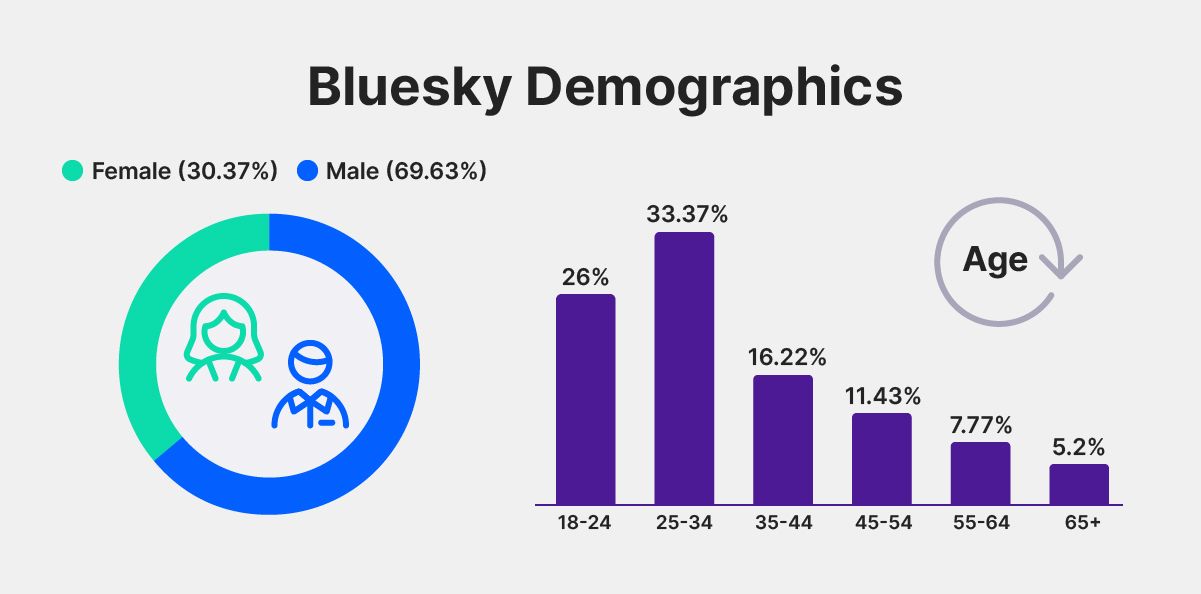How Many Users Does Bluesky Have? 32+ Bluesky Stats (2024)

Dave Ver Meer · Updated: December 7, 2024

Bluesky made headlines last year and user growth has been steady since then, largely thanks to unpopular changes made on X (Twitter) by Musk.
It currently has over 24.5 million users and gained more than 5 million in the two weeks following the results of the US presidential election.
With users splitting their time between Threads, Mastodon, and Bluesky, many are hoping that this year we'll see a clear alternative to X emerge.
In this article, we’ll explore all the latest statistics and facts you’d want to know about, including the number of users, app downloads, and traffic.
Contents
Top Bluesky stats
-
According to the latest data from Bluesky, it currently has over 24.5 million users.

-
In the two weeks following the US presidential election, over 5 million users flocked to Bluesky from X.
-
During the first day after ending the invite-only period, Bluesky gained over 800,000 users. That’s almost a 30% increase.
-
About 4 months after launching, the Bluesky app reached 1 million installs. 40% of installs were from the U.S. alone.
-
Bluesky has raised a total of $21 million in funding, most recently raising $8 million from a seed round.
-
Users have created over 720 million posts on Bluesky.
-
In September, the Bluesky app had 445,000 total downloads, with 251,000 coming from iOS and 194,000 from Android.
-
The largest age group of visitors to Bluesky's website is 18-24 year olds.
Sources: The New Yorker, CNBC, Ars Technica, Twexit, Bluesky, TechCrunch, Statista
How many users does Bluesky have?
Bluesky currently has over 24.5 million users. Since the launch of its beta in 2022, Bluesky has steadily grown its user base.
Overview
| Headquarters | Seattle, Washington |
|---|---|
| Founders | Jack Dorsey |
| Owned by | Bluesky Public Benefit C Corp (Not owned by X, though formerly incubated within Twitter) |
| Leadership | Jay Graber (CEO) |
| Funding | Seed round ($8 million), Twitter ($13 million), Jack Dorsey (Series A) |
| Number of users | 24.5 million users |
| Technology | AT Protocol (decentralized) |
Bluesky traffic stats
According to Similarweb, Bluesky's website had a surge in traffic early last year, topping out at 2 million in April last year.
With 443,000 visits in March, the website visitor count was down 63% from February when it had 1.2 million. The steep drop may be due to the fact that Bluesky ended its beta period in early February.
Each visitor views an average 1.51 pages and spends an average of 1 minute and 24 seconds on the site. 44.1% of visits are direct and the second biggest traffic contributor is from referrals (29.06%).
Here’s a breakdown of the top marketing channels that drive traffic to Bluesky.
| Rank | Marketing Channel | Traffic Share |
|---|---|---|
| 1 | Direct | 44.1% |
| 2 | Referrals | 29.06% |
| 3 | Organic Search | 21.26% |
| 4 | Social | 4.79% |
| 5 | 0.75% | |
| 6 | Display | 0.04% |
Source: Similarweb
Bluesky visitor stats
The US was the largest contributor to Bluesky’s website traffic (44.39%). In other words, 4 in 10 visits are from the US.

Japan comes in second place with 6.92%, followed by Brazil (4.12%).
Here’s a breakdown of Bluesky visitors by region:
| Rank | Country | Traffic |
|---|---|---|
| 1 | US | 44.39% |
| 2 | Japan | 6.92% |
| 3 | Brazil | 4.12% |
| 4 | Germany | 3.92% |
| 5 | United Kingdom | 3.14% |
| - | Others | 37.51% |
Source: Similarweb
Bluesky demographic stats
The makeup of visitors to Bluesky’s website is 30.37% female and 69.63% male. The largest age group is 25-34 year olds (33.37%), followed by 18-24 year olds (26%).
Combined, 18-34 year olds make up over half (59.37%) of the traffic.

Source: Similarweb
Bluesky facts
-
After a long wait, Bluesky now lets users send and receive direct messages (DMs). The feature includes the option for users to limit DMs to only people they follow.
-
Jack Dorsey is no longer on the board of Bluesky and revealed that the reason he left is because Bluesky is making the same mistakes as Twitter (now called X).
-
Bluesky launched Ozone, a tool that lets users build and run their own moderation service.
-
Bluesky's first third-party app, Graysky, launched on the App Store. It has features that are missing in Bluesky, like support for GIFs, viewing people's likes, a feed layout, and hashtag support.
-
Bluesky is built on the AT Protocol, an open-source technology that allows users to move between hosts without losing their data and identity.
-
Late last year, Bluesky launched new safety tools to help moderate content by automating the process. Users will also be able to report posts to help correct mislabeled content.
-
Posts on Bluesky are best known as "skeets" (a combo of "sky" and "tweet"), even though company leaders have pleaded with users to call them something else.
-
Bluesky features domains as handles as an added trust signal. For example, the president of the US could have the handle, “@potus.whitehouse.gov”.
Sources: Vox, Bloomberg, Bluesky, Engadget, TechCrunch1, Open RSS, TechCrunch2, Time, 9to5Mac
What is Bluesky?
Bluesky is a decentralized, social network that is considered a front-runner as an alternative to X (formerly Twitter). It lets you post 300-character posts and replies. You can also repost and share photos. According to the CEO, Jay Graber, it's “a very simple microblogging format to show how Twitter could have been built” using its open protocol.
You can also search for people, mute, and block accounts. As far as posts go, you can reply, repost, and like them.
One notable, unique feature is the ability to claim a more authoritative and trustworthy handle using a domain you already own. So if you own “yourdomain.com”, you could go through a verification process and have the handle “@yourdomain.com”.
Is Bluesky still invite-only?
Anyone can now join Bluesky. You no longer need an invite to join now that they've ended their year long private beta period.
Who owns Bluesky?
Bluesky is owned by Bluesky PBLLC (Public Benefit LLC), which was formed in late 2021. Bluesky split off from Twitter (now X) in early 2022. Around that time, Twitter also invested $13 million in Bluesky. Some confusion about the ownership comes from the fact that Bluesky started out as part of Twitter.
In a Tweet, Jay Graber (CEO) went out of her way to clarify the ownership status, by stating, “I think it's worth re-iterating here that Jack is on our board but Jack does not own us.” She went on further to say, “Twitter does not own us.”
Who started Bluesky?
Bluesky was started as a project by Twitter founder Jack Dorsey to realize his vision of an open, decentralized platform. One where users would have the choice to take their profile and social graph to move to another platform. It later split off into its own company in early 2022, and its current CEO is Jay Graber.
Why has Bluesky become popular?
Since Elon Musk bought Twitter, he’s made a series of changes aimed at removing restrictions around speech and having to pay for verification, which have prompted users to leave and seek out alternatives. Bluesky users have described it as a refreshing change, with fewer people who are mean and more that have fun.
Is Bluesky open-source?
Bluesky uses the AT Protocol, an open-source technology pioneered by Bluesky that allows users to move between hosts without losing their data and identity. Recently, Bluesky's app codebase was made open-source so that others can improve and build on top of it.
How does Bluesky control misinformation?
Bluesky has added a feature to warn users by flagging misleading links. When a link shared by a user doesn't match the text in the post, the app will warn others that the link might take them somewhere that they don't expect.
What's the difference between Bluesky and Mastodon?
Both of them have a similar architecture underneath that allows users to own their own data and make it portable. The main difference between them is that Bluesky is easier to use and get started with.
Wrapping up
Waves of users have been jumping ship from X since it was acquired by Musk, and that trend is only continuing to escalate so far.
Now that the beta period has ended, Bluesky has the potential to become the leading alternative to X (or even overtake it at some point).